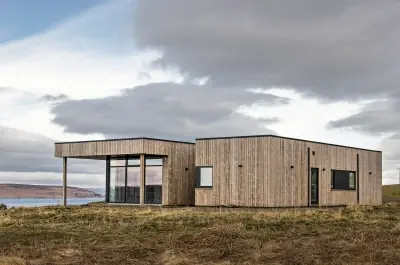Modular home loans in California
Your neighbor just built their dream home in four months. Not with an army of contractors working around the clock, but with sections built in a factory and assembled on-site like a sophisticated puzzle. Welcome to modular construction. Consider bank statement loans for contractor.
Modular homes shatter every assumption about factory-built housing. These aren’t manufactured homes or trailers. They’re custom houses built indoors under controlled conditions, then delivered and assembled on permanent foundations just like traditional homes.
California’s 2025 building codes make modular construction even more attractive. Factory-controlled environments ensure compliance with strict energy efficiency requirements while offering customization options that would challenge site-built construction. Consider construction-to-permanent loans for building.
Modular vs. Everything Else
Let’s clear up the confusion about factory-built homes. Modular, manufactured, and prefab aren’t interchangeable terms - they represent completely different construction methods and financing approaches.
Modular homes are built to local building codes - the same codes governing site-built houses. This means they qualify for traditional mortgages, appreciate like regular real estate, and meet California’s specific requirements.
Manufactured homes follow HUD federal codes instead of local standards. While modern manufactured homes offer quality housing, they require specialized financing and don’t always appreciate like traditional real estate.
Prefab is just a construction method - building components off-site then assembling them. Modular homes are one type of prefab construction, but so are some high-end custom homes.
What Is the Quality Factor for Modular Home Financing in California?
Factory construction often produces superior quality compared to site-built homes. Indoor assembly protects materials from weather. Quality control systems catch problems before installation. No rushing to beat rain storms.
California’s strict seismic and energy codes get implemented more precisely in controlled factory environments. Every joint, connection, and insulation detail gets proper attention.
One-Time Close Construction Loans
Traditional construction requires two loans - a construction loan, then a permanent mortgage. You qualify twice, close twice, and hope rates don’t jump during construction.
One-time close modular loans eliminate this hassle. You qualify once, close once, and lock your permanent mortgage rate before construction begins. The loan automatically converts when construction completes.
This approach saves thousands in closing costs and protects against rate increases during your build. Your monthly payment stays predictable from day one.
Interest-only payments during construction keep carrying costs manageable. You only pay interest on drawn funds as construction progresses, not the full loan amount.
When Should You Lock Your Interest Rate?
Modular construction timelines make rate locks practical. Traditional construction taking 12-18 months challenges standard 60-90 day lock periods. Modular homes completing in 2-6 months fit comfortably within lock periods.
Some lenders offer extended locks for modular construction, knowing the shorter and more predictable timelines reduce their risk.
Rates change daily based on your credit, down payment, and property type. Contact us for your personalized rate quote.
California Building Code Advantages
California’s 2025 building energy efficiency standards emphasize heat pumps, electric-ready construction, and enhanced ventilation. Factory construction handles these requirements more effectively than field installation.
Precise installation matters enormously for energy efficiency. Factory assembly allows perfect insulation installation, accurate HVAC sizing, and sealed building envelopes that field construction struggles to achieve.
California’s seismic requirements get implemented consistently in factory settings. Structural connections, shear walls, and foundation anchoring receive proper attention without weather delays or field complications.
ADU regulations favor modular construction. California’s streamlined 2025 ADU laws make modular accessory dwelling units increasingly popular. Factory construction speeds approval and reduces neighbor concerns.
What Are the Key Benefits?
Modular homes often exceed California’s energy requirements by significant margins. Factory assembly allows precise installation of advanced insulation, high-performance windows, and integrated HVAC systems.
Solar-ready designs and electric vehicle charging preparation become standard features rather than expensive add-ons. California’s rebates and incentives often apply to these energy features.
Customization Without Compromise
Think factory-built means cookie-cutter designs? Modern modular manufacturers offer extensive customization options rivaling high-end custom builders.
Floor plan modifications include room additions, layout changes, and architectural details. Many companies design completely custom homes rather than just offering catalog options.
Finish selections span from builder-grade to luxury specifications. Hardwood floors, granite counters, custom cabinetry, and premium fixtures all work with modular construction. Consider jumbo loans in California for luxury.
Architectural styles range from traditional to ultra-modern. California’s diverse design preferences - from Craftsman to contemporary - all work with modular construction methods.
What Are the Latest Modular Home Design Trends in California?
Indoor-outdoor living so popular in California gets enhanced through modular construction. Large sliding doors, outdoor kitchens, and seamless transitions are easier to achieve with factory precision.
Sustainable materials and energy features align with California’s environmental focus. Modular manufacturers often lead in green building practices and certification programs.
Construction Timeline Reality
Traditional California home construction averages 12-18 months when everything goes perfectly. Add permit delays, weather, and contractor scheduling, and timelines stretch even longer.
Modular construction compresses timelines dramatically. Factory construction happens simultaneously with site preparation. While your foundation gets poured, your house gets built indoors.
Total timelines typically run 2-6 months from groundbreaking to occupancy. Site complexity, customization level, and permit processing affect timelines, but modular construction eliminates most weather and labor delays.
Parallel construction means your house is 80% complete when delivered to your lot. Final assembly, utility connections, and finish work complete quickly compared to traditional construction.
How Does Weather Independence Benefit California Modular Home Construction?
California’s construction season runs year-round, but winter rains still delay traditional construction. Factory construction ignores weather completely.
Consistent factory schedules allow precise delivery coordination. No wondering if your house will be ready by your lease expiration or school enrollment deadlines.
Financing Program Options
Modular homes qualify for every financing program available to site-built homes. No special requirements, restrictions, or limitations apply.
FHA loans with 3.5% down work perfectly for modular construction. VA loans with zero down for veterans. Conventional loans with down payments from 3-20%. Jumbo loans for high-value properties.
USDA rural development loans support modular construction in eligible areas. These zero-down loans help rural California residents access modern, energy-efficient housing. Consider USDA loans in California for rural.
Construction loan options include one-time close and traditional two-time close programs. Most borrowers prefer one-time close for the rate protection and simplified process.
These are general guidelines - exceptions exist. Give us a call because we can usually work around these guidelines with the right lender match.
How Much Down Payment Is Required?
California’s down payment assistance programs apply to modular homes just like site-built construction. CalHFA programs, local assistance, and employer programs all work. Consider down payment assistance programs for down payment assistance.
ADU construction grants up to $40,000 help qualifying homeowners add modular accessory dwelling units. These grants significantly reduce effective down payment requirements.
Site Preparation Requirements
Modular homes require proper site preparation just like traditional construction. Foundation work, utility connections, and access roads must be completed before module delivery.
Foundation requirements follow local building codes. California’s seismic standards demand engineered foundations regardless of construction method. Modular homes use the same foundation systems as site-built houses.
Utility planning becomes crucial for modular construction. Electrical, plumbing, and HVAC connections must align precisely with factory-built modules. Professional coordination prevents expensive modifications.
Delivery access requires consideration during planning. Large truck access, crane positioning, and neighbor coordination ensure smooth installation.
What Site Challenges Affect Modular Home Loans in California?
Hillside lots popular in California require specialized foundation and access planning. Modular manufacturers understand these challenges and design accordingly. Consider land loans for lot.
Coastal areas with salt air exposure, seismic zones, and fire-prone regions all affect modular design and installation. California-experienced manufacturers understand these local considerations.
Quality Control Advantages
Factory construction allows quality control systems impossible in field construction. Climate-controlled assembly, precision tools, and systematic inspections produce superior results.
Material handling in factory settings prevents weather damage, warping, and moisture intrusion common in field construction. Lumber stays straight, drywall stays dry, and finishes remain pristine.
Multi-point inspection systems catch problems before installation. Field construction relies on periodic inspections that might miss problems until after installation.
Skilled craftsmen in factory settings develop expertise through repetition. The same workers build similar components repeatedly, improving quality through experience.
What California Building Standards Apply to Modular Home Financing?
California’s strict building standards get implemented more consistently in factory settings. Energy code compliance, accessibility requirements, and safety standards receive systematic attention.
Third-party inspections verify compliance before delivery. On-site assembly gets final inspections, but most quality control happens in the factory where corrections are easier.
Long-Term Value Considerations
Modular homes on permanent foundations appreciate like site-built homes because they ARE site-built homes - just assembled differently.
California’s strong real estate market supports modular home values equally with traditional construction. Location, design quality, and market conditions drive values, not construction method.
Resale markets don’t distinguish between modular and site-built construction when homes meet the same building codes and quality standards.
Energy efficiency often makes modular homes more valuable over time. Lower utility costs and environmental benefits appeal to California’s eco-conscious buyers.
What Insurance and Maintenance Considerations Affect Modular Home Loans?
Homeowner’s insurance treats modular homes identically to site-built homes. No special requirements or rate adjustments apply when construction meets building codes.
Maintenance requirements match traditional homes. Factory construction often reduces initial maintenance needs through superior quality control.
California Market Opportunities
California’s housing crisis creates opportunities for modular construction to provide quality housing at competitive costs and timelines.
ADU development represents huge modular opportunities. Homeowners seeking rental income or multigenerational living find modular ADUs attractive for speed and quality.
First-time buyers benefit from modular homes’ cost efficiencies and financing accessibility. Traditional home prices push many buyers toward alternative construction methods. Consider FHA loans in California for first-time buyer.
Move-up buyers appreciate modular construction’s customization options and construction timelines. Building your next home while living in your current one becomes practical.
Which California Regions Offer the Best Opportunities?
California’s diverse markets offer different modular opportunities. Rural areas with land availability. Suburban infill development. Urban ADU projects.
Each region presents unique opportunities and challenges. Working with California-experienced modular manufacturers ensures local knowledge and proper execution.
Making Modular Decisions
Modular construction works best for buyers who value quality, speed, and customization. Understanding the process helps set appropriate expectations.
Design planning takes more upfront time than traditional construction. Factory schedules require complete plans before production begins. Changes become expensive once construction starts.
Site selection considers delivery access and assembly requirements. Beautiful hilltop lots might require expensive crane access for module placement.
Builder selection matters enormously. Choose manufacturers with California experience, local dealer networks, and quality track records.
What Timing Considerations Matter for Modular Home Financing in California?
Modular construction timelines work well for buyers with specific deadlines - school enrollment, lease expirations, job relocations. Predictable schedules reduce stress and complications.
Factory production schedules sometimes extend during peak demand periods. Planning ahead ensures your preferred delivery timing. Consider bridge loans in California for timing.
Next Steps
Every modular home project involves unique design requirements, site conditions, and financing considerations. Understanding these factors helps structure successful projects.
Our modular construction lending team understands factory-built home financing and California’s specific requirements. We’ll help you navigate construction loans and coordinate with manufacturers for smooth project completion.
California’s modular home market offers innovative solutions to housing challenges while maintaining quality and financing accessibility. Call (510) 589-4096 to discuss modular home financing or view all property type programs.
Explore More Property Types
Not sure if modular homes fit your situation? Compare our other property type programs including manufactured homes (affordable HUD construction), single family homes (site-built traditional), and condos (urban low-maintenance living) to find the perfect property type for your California home.


